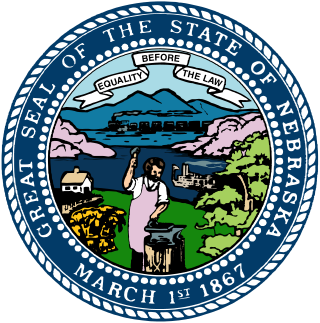
The 2006 Texas General Election was held on Tuesday, 7 November 2006, in the U.S. state of Texas. Voters statewide elected the Governor, Lieutenant Governor, Attorney General, Comptroller of Public Accounts, Commissioner of the General Land Office, Commissioner of Agriculture, and one Railroad Commissioner. Statewide judicial offices up for election were the chief justice and four justices of the Texas Supreme Court, and the presiding judge and two judges of the Texas Court of Criminal Appeals.

Elections to the 48th Arizona Legislature were held on November 7, 2006. Primary elections to determine political party nominees were held on September 12, 2006. The two candidates with the highest vote count in each primary advanced to the November election.

The Republican State Committee of Delaware is the affiliate of the United States Republican Party in Delaware. It has regional offices in Dover, Newark, North Wilmington, and Georgetown.

The 2010 New York state elections took place on November 2, 2010. Due to the special election for US Senate, all of New York's six statewide offices were up for popular election on the same date. At the same time, all 29 members from New York of the U.S. House of Representatives, all 212 members of the New York State legislature, and many other local officials were elected.

The 2011 United States elections were held on Tuesday, November 8. This was an off-year election, in which the only seats up for election in the United States Congress were special elections. There were also four gubernatorial races, including a special election in West Virginia. There were also state legislative elections in four states and judicial elections in three states; as well as numerous citizen initiatives, mayoral races, and a variety of other local offices on the ballot.

The 2012 United States Senate election in Tennessee took place on November 6, 2012, as part of the general election including the 2012 U.S. presidential election, elections to the House of Representatives and various state and local elections. Incumbent Republican U.S. Senator Bob Corker won a second term in a landslide, carrying all but two counties in the state.

The 2012 New York state elections took place on November 6, 2012. These elections included the 2012 presidential election, an election to one U.S. Senate seat, and elections to all 27 New York congressional seats, all 63 seats in the New York State Senate, and all 150 seats in the New York State Assembly.

The 2018 United States elections were held on Tuesday, November 6, 2018. These midterm elections occurred during Incumbent Republican President Donald Trump's term. Although the Republican Party increased its majority in the Senate, unified Republican control of Congress and the White House was brought to an end when the Democratic Party won control of the House of Representatives in what was widely characterized as a "blue wave" election.

A general election was held in the U.S. state of Arizona on November 6, 2018. All of Arizona's executive offices were up for election as well as a United States Senate seat and all of Arizona's nine seats in the United States House of Representatives. The Republican Party won the majority of statewide offices, albeit by much narrower margins than in previous elections, while the Democratic Party picked up three statewide offices.

The 2018 United States House of Representatives elections in Arizona were held on November 6, 2018, to elect the nine U.S. representatives from the State of Arizona, one from each of the state's nine congressional districts. The elections coincided with the 2018 Arizona gubernatorial election, as well as other elections to the U.S. House of Representatives, elections to the United States Senate and various state and local elections. The 2018 general elections saw the Democratic party gain the 2nd congressional district, thus flipping the state from a 5–4 Republican advantage to a 5–4 Democratic advantage, the first time since the 2012 election in which Democrats held more House seats in Arizona than the Republicans.

The 2020 United States Senate special election in Arizona was held on November 3, 2020, following the death in office of incumbent Republican U.S. Senator John McCain on August 25, 2018. Governor Doug Ducey was required by Arizona law to appoint a Republican to fill the vacant seat until a special election winner could be sworn in. On September 5, 2018, Ducey appointed former U.S. Senator Jon Kyl to fill McCain's seat. However, Kyl announced he would resign on December 31, 2018.

The 2018 Nebraska State Legislature elections took place as part of the biennial United States elections. Nebraska voters elected state senators in the 24 even-numbered seats of the 49 legislative districts in the Nebraska Unicameral. Nebraska is unique among American| states in that there is only one chamber in its state legislature, and this chamber is called the Unicameral and the State Legislature interchangeably. State senators serve four-year terms in the Nebraska Unicameral.

Kentucky state elections in 2018 were held on Tuesday, November 6, 2018, with the primary elections being held on May 22, 2018. These midterm elections occurred during the presidency of Republican Donald Trump and the governorship of Republican Matt Bevin, alongside other elections in the United States. All six of Kentucky's seats in the United States House of Representatives, nineteen of the 38 seats in the Kentucky State Senate, all 100 seats in the Kentucky House of Representatives, and one of the seven seats on the Kentucky Supreme Court were contested. Numerous county and local elections were also contested within the state.

Elections were held in the U.S. state of Arizona on November 3, 2020, as part of the 2020 General Election. Arizona voters chose 11 electors to represent them in the Electoral College via a popular vote. Three seats on the Arizona Corporation Commission were up for election, as were all nine of Arizona seats in the United States House of Representatives, and one of its seats in the United States Senate. Primary elections were held in August 2020. Paper ballots for voting by mail were sent to all registered voters in the state.

The 2018 Connecticut Senate election was held on November 6, 2018, concurrently with the elections for the Connecticut House of Representatives, to elect members to the Connecticut General Assembly. All 36 seats in the Connecticut Senate were up for election. The election resulted in Democrats expanding control in both chambers of the Connecticut General Assembly, ending the split control in the Senate, that had been in place since the 2016 elections. Primary elections were held on August 14, 2018.

The 2020 New Hampshire Senate elections took place as part of the biennial 2020 United States elections. New Hampshire voters elected state senators in all of the state's 24 senate districts. State senators serve two-year terms in the New Hampshire Senate, with all of the seats up for election each cycle. The primary elections on September 8, 2020, determined which candidates will appear on the November 3, 2020, general election ballot.

The 2022 Washington State Senate elections took place as part of the biennial United States elections. Washington state voters elected state senators in 25 of the state's 49 Senate districts. The other 24 state senators were not up for re-election until the next biennial election in 2024. State senators served four-year terms in the Washington State Senate.

The 2022 Oklahoma Senate general election were held on November 8, 2022. The primary elections for the Republican, Democratic, and Libertarian parties' nominations took place on June 28, 2022. Runoff primary elections, if no candidate received 50% in the June 28 vote, took place on August 23. All candidates had to file between the days of April 13–15, 2022. Oklahoma voters elected state senators in 24 of the state's 48 Senate districts. State senators served four-year terms in the Oklahoma Senate.

The 2022 elections for the Florida State Senate took place on Tuesday, November 8, 2022, to elect state senators from all 40 districts. Although on ordinary years, 20 senators are elected at a time on a staggered basis, races following redistricting elect all 40 members to ensure that each member represents an equal number of constituents. The Republican Party expanded their Senate majority from 24 to 28, gaining a supermajority in the Senate. The concurrently held House elections also resulted in a supermajority, giving Republicans supermajority control of the legislature.

The 2022 Vermont Senate election took place on November 8, 2022, as part of the biennial United States elections. The election coincided with elections for other offices including the U.S. Senate, U.S. House, Governor, and State House. Vermont voters elected all 30 state senators from 16 districts, with each district electing between one and three senators. State senators serve two-year terms in the Vermont Senate. Primary elections were held on August 9, 2022. This election will be the first to use new districts adopted by the Vermont General Assembly to allocate for population changes across the state after the 2020 census.























